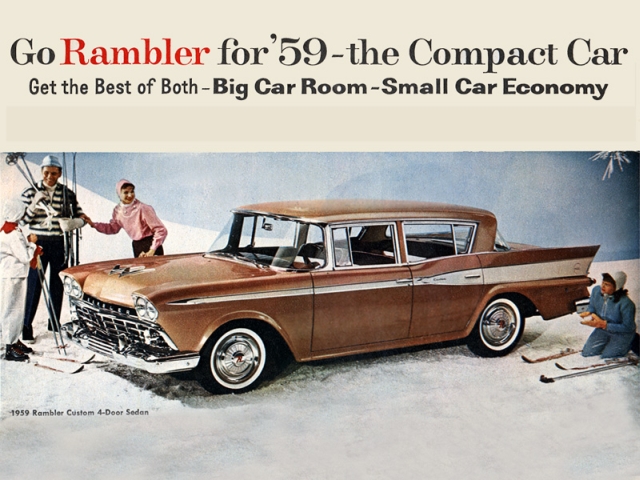 Founded in 1980 by Frank and Elaine Wrenick |
|
|
 Founded in 1980 by Frank and Elaine Wrenick |
|
|
Rambler in High GearReprinted from Time Magazine
Monday Dec. 8, 1958 Edition  While riding in my Cadillac,
While riding in my Cadillac,
What, to my surprise; A little Nash Rambler was following me, About one-third my size . . . Now we're doing a hundred and twenty, As fast as I could go; The Rambler pulled alongside of me, As if I were going slow . . . My fellow rolled down his window And yelled for me to hear, "Hey, buddy, how can I get this car Out of second gear?" —Beep Beep With an added push from the nation's No. 4 pop song, American Motors' "little Nash Rambler" was in high gear last week and setting new records. November production hit a new high of 26,782 cars. For the first two months of its fiscal year (October and November), Rambler almost doubled its last year's production. It accounted for 9.2% of U.S. auto sales in October and is still pushing up speed. Rambler's freewheeling President George Romney scheduled 34,000 cars for December and 32,000 for January. He not only expects to sell 150,000 cars in the first six months of his present fiscal year, but he is ready to expand even more. Because there is a higher net per car as volume increases, American Motors' profits are soaring far higher than the record $4.65 per share posted in fiscal '58. Romney expects to net a minimum of $17.5 million in the first six months, compared to $7.329,631 in the same period a year ago. Wall Streeters are just as optimistic; they figure that if Romney can keep up the hot pace and sell 325,000 cars in the whole year, American Motors will net upwards of $14 a share before taxes. Rambler is not only doing well in the U.S.; it is also expanding its share of the export market. While total U.S. exports slid 16% this year, Rambler's climbed 10.3%. Basic Transportation. The success of the Rambler is not luck but the result of a ten-year-old program. After World War II, the late George Mason, then company president, concluded from market surveys that the U.S. was ready to return to "basic transportation" and a smaller, compact car. While other U.S. cars became costlier and heavier, Mason and his successor, Romney, introduced the first Rambler in 1950, drove it into the field, where the only competition was foreign. To cut costs, Romney consolidated field organization, factories and production, kept model changes at a minimum. He pushed Rambler's break-even point down to a low 120,000 cars a year. Now, he is doing the same thing with the Kelvinator appliance division, which is about to turn the corner. In a year he paid off bank debts of $33,750,000. The most quoted threats to Rambler are the small cars the Big Three talk about bringing out and Studebaker's Lark, introduced this fall, which sells for slightly more than the Rambler American. Last week Ward's Automotive Reports said that General Motors and Ford will have their small cars in production "early in '59." G.M. and Ford declined to comment, but most auto experts think this is much too early, since the companies apparently have not yet placed any production orders for parts. Detroit does not expect Big Three small cars before November 1959, if then. Romney is ready for them, feels that when "the Big Three come into the field, the move itself will confirm our judgment. At the same time, their advertising should enlarge the market." Moreover, Romney points out. the Big Three will be selling as much against their own established big-car lines as against the Rambler, and "from experience, we know this is a handicap." While automen still do not know how big the compact-car market will be, they feel that it is far bigger than they estimated a year ago. In it, Romney thinks his position is well buttressed. "It is doubtful," he says, "if any Big Three maker could profitably operate a compact-car division with double our 120,000-car break-even. We expect a battle and a lot heavier competition. But a lot of it will come from us."
|